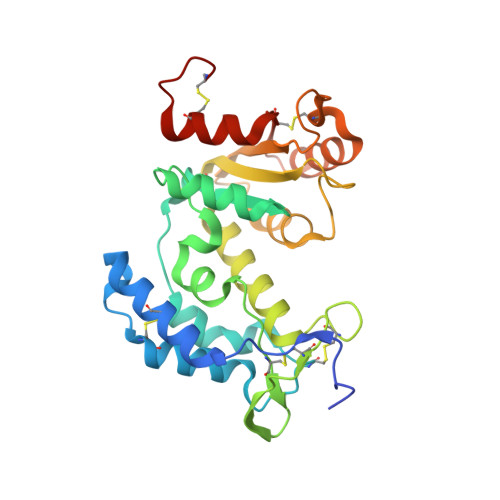Catalysis-associated Conformational Changes Revealed by Human CD38 Complexed with a Non-hydrolyzable Substrate Analog
Liu, Q., Kriksunov, I.A., Moreau, C., Graeff, R., Potter, B.V., Lee, H.C., Hao, Q.(2007) J Biological Chem 282: 24825-24832
- PubMed: 17591784
- DOI: https://doi.org/10.1074/jbc.M701653200
- Primary Citation of Related Structures:
2PGJ, 2PGL - PubMed Abstract:
Cyclic ADP-ribose (cADPR) is a calcium mobilization messenger important for mediating a wide range of physiological functions. The endogenous levels of cADPR in mammalian tissues are primarily controlled by CD38, a multifunctional enzyme capable of both synthesizing and hydrolyzing cADPR. In this study, a novel non-hydrolyzable analog of cADPR, N1-cIDPR (N1-cyclic inosine diphosphate ribose), was utilized to elucidate the structural determinants involved in the hydrolysis of cADPR. N1-cIDPR inhibits CD38-catalyzed cADPR hydrolysis with an IC(50) of 0.26 mM. N1-cIDPR forms a complex with CD38 or its inactive mutant in which the catalytic residue Glu-226 is mutated. Both complexes have been determined by x-ray crystallography at 1.7 and 1.76 A resolution, respectively. The results show that N1-cIDPR forms two hydrogen bonds (2.61 and 2.64 A) with Glu-226, confirming our previously proposed model for cADPR catalysis. Structural analyses reveal that both the enzyme and substrate cADPR undergo catalysis-associated conformational changes. From the enzyme side, residues Glu-146, Asp-147, and Trp-125 work collaboratively to facilitate the formation of the Michaelis complex. From the substrate side, cADPR is found to change its conformation to fit into the active site until it reaches the catalytic residue. The binary CD38-cADPR model described here represents the most detailed description of the CD38-catalyzed hydrolysis of cADPR at atomic resolution. Our structural model should provide insights into the design of effective cADPR analogs.
- MacCHESS, Cornell High Energy Synchrotron Source, Cornell University, Ithaca, New York 14853, USA.
Organizational Affiliation:

















